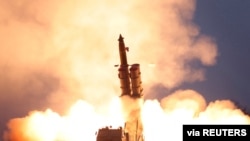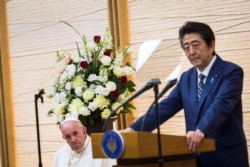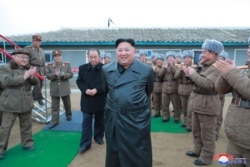North Korea made perhaps its most direct recent threat to resume longer-range missile tests, warning Saturday it may soon launch a “real ballistic missile” in the vicinity of Japan.
Pyongyang has carried out 13 rounds of short- or medium-range launches since May. Most experts say nearly all of the tests have involved some form of ballistic missile technology.
The latest test came Thursday, when North Korea conducted its fourth launch this year of what it called a “super-large, multiple-rocket launch system.”
Japanese Prime Minister Shinzo Abe condemned the launch as a violation of United Nations Security Council resolutions, which prohibit North Korea from any ballistic missile activity.
On Saturday, the official Korean Central News Agency published an article condemning Abe’s statement, saying the test involved a “multiple launch rocket” and not a ballistic missile.
“Abe may see what a real ballistic missile is in the not distant future and under his nose,” KCNA said in a statement attributed to North Korean foreign ministry official.
North Korean leader Kim Jong Un has set an end-of-year deadline for the United States to offer more concessions in nuclear talks that have been stalled since February.
As that deadline approaches, North Korean officials have repeatedly issued veiled warnings about bigger provocations, though none appear to have been as direct as Saturday’s statement.
Direct threat
North Korea last tested an intercontinental ballistic missile in November 2017 and conducted a nuclear test in September 2017.
In April 2018, Kim announced a self-imposed moratorium on ICBM and nuclear tests, saying North Korea “no longer need(s)” those tests.
Recently, North Korean officials have issued reminders that North Korea’s pause on ICBM and nuclear tests was self-imposed and can be reversed.
This year has been one of North Korea’s busiest in terms of missile launches. The North has launched 13 rounds of weapons since May.
U.S. President Donald Trump has said he has “no problem” with the tests, since they are short-range and cannot reach the United States.
Some U.S. allies in the region disagree. Japan, which is within reach of North Korea’s short-range missiles, has consistently condemned Pyongyang for the tests.
North Korea has shot back, issuing fiery statements at Abe.
Saturday’s KCNA article referred to Abe as a “political dwarf without parallel,” a “rare-to-be-seen deformed child,” and “puppy affected by mange.”
KN-25
North Korea’s most recent test involved the KN-25, a solid-fueled, road-mobile, multiple rocket-launch system.
Many analysts consider the KN-25 to be a “ballistic missile” system, because it fires such large weapons.
“The ‘super-large’ rocket blurs the distinction between multiple-launch rocket systems (MLRS) and short-range ballistic missiles,” according to the CSIS Missile Defense Project.
By repeatedly testing the KN-25, defense analysts say North Korea has successfully reduced the amount of time it takes to launch successive rockets from the system.
“The faster it fires, the quicker it can get out of Dodge before counter-fire arrives,” Jeffrey Lewis, an expert in nuclear nonproliferation with the Middlebury Institute of International Studies at Monterey, said on Twitter.
During the first two tests of the KN-25 in August and September, 15 to 20 minutes passed between launches. In a subsequent October test, that number was reduced to 3 minutes. On Thursday, Seoul’s military estimated there were only 30 seconds between shots.


